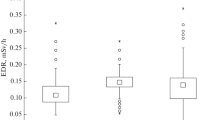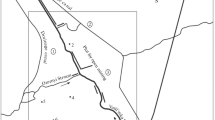Abstract
Data on the concentrations of natural (226Ra, 232Th and 40K) and artificial (137Cs) radionuclides and on the physicochemical properties of chernozems sampled in different years are presented. In 1952, upon the creation of the Penza-Kamensk state shelterbelt, three deep (up to 3 m) soil pits were examined within the former arable field under two-year-old plantations of ash and maple along the transect crossing the territory of the Beloprudskaya Experimental Station of the USSR Academy of Sciences in Volgograd oblast. The samples from these pits were included into the collection of dated soil samples of the Dokuchaev Central Soil Science Museum. Five pits were examined along the same transect in 2009: three pits under shelterbelts (analogues of the pits studied in 1952) and two pits on arable fields between the shelterbelts. In the past 57 years, certain changes took place in the soil structure, bulk density, and the content and composition of humus. The salt profile of soils changed significantly under the forests. The comparison of distribution patterns of natural soil radionuclides in 1952 and 2009 demonstrated their higher contents at the depth of 10–20 cm in 2009 (except for the western shelterbelt). Background concentrations of natural radionuclides in parent materials and relationships between their distributions and the salt profiles of soils have been determined; they are most clearly observed is the soils under shelterbelts. Insignificant contamination with 137Cs (up to 34 Bq/kg) has been found in the samples of 2009 from the upper (0–20 cm) horizon. The activity of 137Cs regularly decreases from the east to the west; the highest concentrations of this radionuclide are found in the topmost 10 cm. This allows us to suppose that 137Cs was brought with aerial dust by eastern winds, and the shelterbelts served as barriers to the wind flow.
Similar content being viewed by others
References
Activity of Radionuclides in Countable Samples. Methodology of Measurements on Gamma Spectrometers Using the SpectraLine Software (Mendeleevo, 2014) [in Russian].
R. M. Aleksakhin, N. I. Sanzharova, S. I. Spiridonov, and S. V. Fesenko, “Chernobyl and the environment,” Radiats. Biol., Radioekol. 47 (2), 196–203 (2007).
N. P. Arkhipov, V. P. Mamedov, L. A. Grishina, and T. A. Fedorova, “Behavior of natural technogenic radionuclides in soils,” Ekologiya, No. 1, 31–38 (1982).
E. A. Afanas’eva, Water-Salt Regime of Ordinary and Southern Chernozems in the Southeast of the European Part of the Soviet Union (Nauka, Moscow, 1980) [in Russian].
A. O. Barsukov and D. V. Yazykeev, “Horizontal and vertical migration of 40K, 137Cs, 226Ra, 232Th, and 241Am in agrolandscapes on cultivated slopes of different steepness in Penza oblast,” Izv. Penz. Gos. Pedagog. Univ. im. V.G. Belinskogo, No. 29, 369–374 (2012).
M. K. Bogatova, A. I. Shcheglov, and O. B. Tsvetnova, “Spatial heterogeneity of radioactive pollution of soils in forest phytocenoses of Tula oblast,” Aktual. Probl. Lesn. Kompl., No. 10, 78–81 (2005).
E. A. Buraeva, V. S. Malyshevskii, T. V. Varduni, E. I. Shimanskii, A. N. Tribolina, A. A. Goncharenko, L. Yu. Goncharova, V. S. Totskaya, and V. S. Nefedov, “Content and distribution of natural radionuclides in different soils types in Rostov oblast,” Sovrem. Probl. Nauki Obraz., No. 4, 1–9 (2013).
L. A. Vorob’eva, Theory and Practice of the Chemical Analysis of Soils (GEOS, Moscow, 2006) [in Russian].
P. D. Gurin, B. F. Aparin, and E. Yu. Sukhacheva, “Influence of forest plantations and long-term agricultural use on the properties of southern chernozems,” Vestn. S.-Peterb. Gos. Univ. 3 (2), 109–119 (2012).
E. A. Dmitriev, Mathematical Statistics in Soil Science (Moscow State Univ., Moscow, 1995) [in Russian].
A. V. Konoplev, V. N. Golosov, V. I. Yoschenko, K. Nanba, Y. Onda, T. Takase, and Y. Wakiyama, “Vertical distribution of radiocesium in soils of the area affected by the Fukushima Dai-ichi nuclear power plant accident,” Eurasian Soil Sci. 49, 570–580 (2016).
S. V. Lukin and A. F. Greber, “Distribution pattern of radionuclides in soil profiles of Belgorod oblast,” Dostizh. Nauki Tekh. APK, No. 1, 19–20 (2008).
E. V. Mingareeva, “Use of a collection of monoliths to study the natural radiation background of Russian soils, Proceedings of International Scientific Conference (XVI Dokuchaev Conference of Young Scientists) “The Laws of Soil Science: New Challenges” (Moscow, 2013), pp. 195–198.
D. S. Orlov and L. A. Grishina, Practical Manual on Humus Chemistry (Moscow State Univ., Moscow, 1981) [in Russian].
F. I. Pavlotskaya, Migration of Radioactive Products of Global Emissions in Soils (Atomizdat, Moscow, 1974) [in Russian].
A. I. Popov, V. M. Igamberdiev, and Yu. V. Alekseev, Statistical Analysis of Experimental Data (St. Petersburg State Univ., St. Petersburg, 2009) [in Russian].
Natural Radiation Background: Origin and Evolution (Southern Federal Univ., Rostov-on-Don, 2007) [in Russian]
Radiation Situation in Russia and Adjacent Countries in 2013: Yearbook (Obninsk, 2014) [in Russian].
O. G. Rastvorova, Soil Physics (Leningrad State Univ., Leningrad, 1983) [in Russian].
N. G. Rachkova, I. I. Shuktomova, and A. I. Taskaev, “The state of natural radionuclides of uranium, radium, and thorium in soils,” Eurasian Soil Sci. 43, 651–658 (2010).
N. I. Sanzharova, A. A. Sysoeva, N. N. Isamov Jr., R. M. Aleksakhin, V. K. Kuznetsov, and T. L. Zhigareva, “Role of chemistry in rehabilitation of agricultural resources affected by radioactive pollution,” Ross. Khim. Zh. 49 (3), 26–34 (2005).
A. N. Silant’ev, I. G. Shkuratova, and Ts. I. Bobovnikova, “Vertical migration of Chernobul-derived radionuclides in soils,” At. Energiya 66 (3), 194–197 (1989).
N. A. Titaeva, Nuclear Geochemistry (Moscow State Univ., Moscow, 2000) [in Russian].
A. A. Titlyanova, “Cesium sorption by layered soil minerals,” Pochvovedenie, No. 12, 88–94 (1964).
A. D. Fokin, A. A. Lur’e, and S. P. Torshin, Agricultural Radiology (Lan’, St. Petersburg, 2011) [in Russian].
Chemical Analysis of Soils (St. Petersburg State Univ., St. Petersburg, 1995) [in Russian].
O. B. Tsvetnova and A. S. Novikova, “Radioecological situation in the forest and agricultural ecosystems of Tula oblast,” Aktual. Probl. Lesn. Kompl., No. 13, 253–257 (2006).
“Environmental consequences of the Chernobyl accident and their remediation: twenty years of experience,” Report of the Chernobyl Forum Expert Group “Environment” (International Atomic Energy Agency, Vienna, 2006), p. 166.
S. Forsberg, A. Rosen, V. Fernandez, and H. Juhan, “Migration of 137Cs and 90Sr in undisturbed soil profiles under controlled and close-to-real conditions,” J. Environ. Radioact. 50, 235–252 (2000).
M. E. P. Gomes, L. M. O. Martins, L. J. P. F. Neves, and A. J. C. S. Pereira, “Natural radiation and geochemical data for rocks and soils, in the North International Duoro Cliffs (NE Portugal),” J. Geochem. Explor. 130, 60–64 (2013).
J. Koarashi, M. Atarashi-Andoh, T. Matsunaga, and T. Sato, “Factors affecting vertical distribution of Fukushima accident-derived radiocesium in soil under different land-use conditions,” J. Sci. Total Environ. 431, 393–401 (2012).
H. Koch-Steindl and G. Prohl, “Considerations on the behavior of long-live radionuclides in the soil,” J. Radiat. Environ. Biophys. 40, 93–104 (2001).
E. Mingareeva and M. Lasareva, “Using a collection of soil monoliths for the study of natural radiation of soils in Russia,” Proceedings of the 20th World Congress of Soil Science (Jeju, 2014), pp. 1–12.
Author information
Authors and Affiliations
Corresponding author
Additional information
Original Russian Text © B.F. Aparin, E.V. Mingareeva, N.I. Sanzharova, E.Yu. Sukhacheva, 2017, published in Pochvovedenie, 2017, No. 12, pp. 1457–1467.
Rights and permissions
About this article
Cite this article
Aparin, B.F., Mingareeva, E.V., Sanzharova, N.I. et al. Concentrations of Radionuclides (226Ra, 232Th, 40K, and 137Cs) in Chernozems of Volgograd Oblast Sampled in Different Years. Eurasian Soil Sc. 50, 1395–1405 (2017). https://doi.org/10.1134/S106422931712002X
Received:
Published:
Issue Date:
DOI: https://doi.org/10.1134/S106422931712002X




